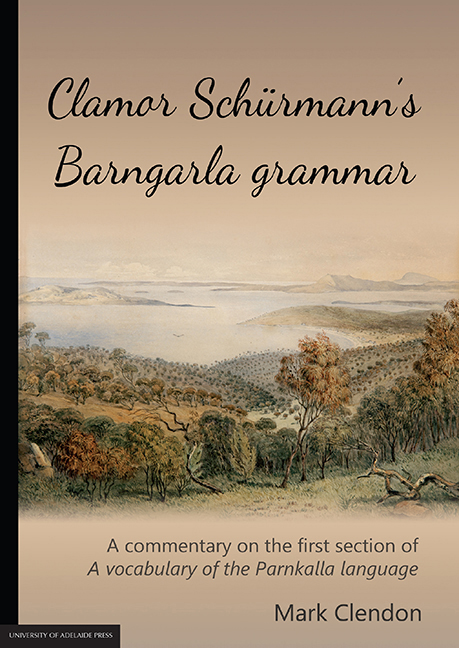 Clamor Schürmann's Barngarla grammar
Clamor Schürmann's Barngarla grammar Book contents
- Frontmatter
- Frontispiece
- Contents
- Abbreviations used in glossing sentence examples & in the text
- Preface
- Map: The northern and western Thura-Yura languages
- 1 Introduction
- 2 Writing Barngarla sounds
- 3 Pronouns
- 4 Intransitive verbs
- 5 Transitive verbs
- 6 Harry Crawford's Barngarla verbs
- 7 Suffixes on nouns
- 8 Other suffixes
- 9 Demonstrative & interrogative pronouns
- 10 Verbal derivational affixes
- 11 Non-finite verbs
- 12 Putting words together
- 13 Prospect
- Appendix The name Barngarla
- References
13 - Prospect
Published online by Cambridge University Press: 05 February 2016
- Frontmatter
- Frontispiece
- Contents
- Abbreviations used in glossing sentence examples & in the text
- Preface
- Map: The northern and western Thura-Yura languages
- 1 Introduction
- 2 Writing Barngarla sounds
- 3 Pronouns
- 4 Intransitive verbs
- 5 Transitive verbs
- 6 Harry Crawford's Barngarla verbs
- 7 Suffixes on nouns
- 8 Other suffixes
- 9 Demonstrative & interrogative pronouns
- 10 Verbal derivational affixes
- 11 Non-finite verbs
- 12 Putting words together
- 13 Prospect
- Appendix The name Barngarla
- References
Summary
This commentary is just that: it is intended as an exegesis of the first section of Schurmann's Barngarla vocabulary, and no more. It certainly does not pretend to encompass all that we are able to know or find out about Barngarla grammar.
For example, the vocabulary is full of untranslated sentence examples, added from Schurmann's manuscript notes by Schurmann himself in or about 1884. As an example of such a sentence, note the following, appearing under a lemma pulyallana on page 60, and without a gloss:
Pulyallana, Kukata yerkulludni yura, yakkara mapparrintyarru, pardnuntyuru pallarri yunduntyanna kanyannityanna
The reference appears to be to an old Kukarta man, possibly referred to as Pulyarlanha, in Barngarla country, and to the actions or behaviour of some women; but this is only a guess.
Close examination of the vocabulary section itself would doubtlessly enhance our understanding in a number of ways. Examination of Moonie Davis’ recorded material referred to in Section 1.3 could also advance our knowledge considerably, and complement the information Schurmann has left us.
Just as importantly, a greater understanding of the grammar and lexicon of Adnyamathanha, still a living language, could be of inestimable assistance in clarifying aspects of Barngarla grammar and of the grammar of other Thura-Yura languages, and in extending our knowledge of them. The full and careful documentation of Adnyamathanha must now be an urgent priority in any program of language reclamation envisaged in South Australia.
Despite its brevity, and despite the ongoing gaps in our knowledge, Schurmann's grammar, as well as his vocabulary, continues to be an indispensable starting point for the further exploration of the Barngarla language.
- Type
- Chapter
- Information
- Clamor Schürmann's Barngarla grammarA commentary on the first section of A vocabulary of the Parnkalla language, pp. 171 - 172Publisher: The University of Adelaide PressPrint publication year: 2015
